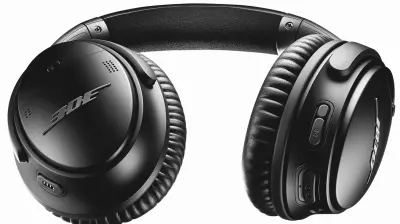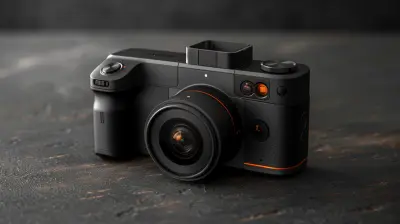Unveiling the Next Big Thing in Wearable Technology
4 March 2025
Wearable technology has come a long way since the first fitness trackers and smartwatches hit the market. What started as a simple step counter has evolved into a full-blown tech revolution strapped to our wrists, woven into our clothes, and even implanted in our bodies. The future of wearables is no longer just about tracking steps or notifying you of an incoming call. Oh no, it’s way more exciting than that.
As we stand on the brink of a new era, tech giants and startups alike are pushing the boundaries of what wearables can do. They’re not just about convenience anymore but about enhancing our daily lives, improving health, and even augmenting reality. So, what’s the next big thing in wearable technology? Buckle up, because we're about to dive deep into the world of futuristic gadgets that might just change how we live.

The Evolution of Wearable Tech: From Fitness to Full Body Integration
When we talk about wearables, it's easy to think of those early fitness trackers that gave us simple analytics like steps and sleep patterns. And yeah, they were cool at the time. But today's wearables? They’re in a whole different league. Fitness bands have evolved into smartwatches, which have become mini-computers on our wrists. Devices like the Apple Watch or Samsung Galaxy Watch now monitor heart rate, blood oxygen levels, sleep cycles, and even detect falls.But here’s the kicker: we’re just scratching the surface. Wearables have moved beyond fitness. We're talking about devices that monitor internal organs, provide augmented reality experiences, improve mental well-being, and integrate seamlessly with the Internet of Things (IoT). The evolution has been fast, and it's only getting faster.
A Glimpse Into the Future: What’s Coming Next?
So, what’s next for wearable tech? Well, if you thought the Apple Watch was impressive, wait until you hear about the advancements that are on the horizon. Imagine wearables that can:- Monitor Your Brain Waves: That’s right, devices like Muse are already giving us a peek into how our brains function during meditation. But future wearables could help us understand our emotions, manage stress, and even treat mental health conditions like anxiety or depression.
- Augment Reality (AR): Smart glasses like Google Glass may not have caught on initially, but AR wearables are far from dead. Companies like Microsoft and Facebook (or should I say Meta?) are heavily investing in AR technologies. Imagine walking down the street and having real-time information displayed right in front of your eyes, from directions to restaurant reviews, all without pulling out your phone.
- Enhance Your Senses: Want to hear like a bat or see in the dark? Wearables that enhance or even augment our natural senses are already in development. These could be a game-changer for people with disabilities, or even just those of us who want to take our sensory experiences to the next level.
- Smart Clothing: Forget about your smartwatch. How about a smart shirt? Companies are experimenting with fabrics that can monitor your heart rate, temperature, and even muscle activity. Athletes could benefit from real-time data on their performance, while everyday users might appreciate the health insights.

Health and Wellness: The Heartbeat of Wearable Innovation
Okay, let’s be real. Health and wellness are the big drivers behind most wearable tech. And for good reason! We’re living in a world where people are more health-conscious than ever before, and the idea of having a personal health assistant on your wrist (or embedded in your clothing) is pretty attractive.Wearables for Chronic Health Conditions
Today, wearables are already helping people with chronic conditions manage their health. Diabetics, for instance, can use continuous glucose monitors (CGMs) that wirelessly transmit blood sugar levels to a smartphone app, allowing for real-time monitoring. But the future holds even more promise.Imagine a wearable that could predict a heart attack before it happens, or detect cancer cells in their earliest stages. These kinds of advancements aren't just science fiction—they're being developed as we speak. Devices that monitor blood pressure, heart rate variability, and even genetic markers could help prevent disease before it strikes. It’s like having a personal doctor with you 24/7.
Mental Health: The New Frontier
While physical health has been the primary focus of wearables, mental health is quickly becoming the next big thing. Devices that monitor stress levels, track sleep quality, and even provide guided meditation sessions are already making their way into the market. But future wearables could go a step further by providing real-time feedback on your emotional state. Imagine a device that could sense when you're starting to feel anxious and provide you with calming techniques before it escalates.It’s like having a built-in therapist, and I don’t know about you, but that sounds pretty great.

Augmented Reality: The Future is Closer Than You Think
You’ve probably heard about augmented reality (AR) and virtual reality (VR) in gaming, but AR wearables are poised to go beyond entertainment. Think about it: instead of staring down at your smartphone, wouldn’t it be amazing to have all the information you need displayed right in front of your eyes?AR Glasses: A Game-Changer?
We’ve already seen early attempts at AR glasses with Google Glass, but they didn’t quite take off. The good news? The tech has matured, and AR glasses are making a comeback. Several companies are working on sleek, unobtrusive AR glasses that could change how we interact with the world around us.Imagine walking into a new city and having directions appear in front of you, or visiting a foreign country and getting real-time translations of street signs. The possibilities are endless, and the best part? You won’t need to keep looking down at your phone.
AR in the Workplace
AR wearables aren’t just for fun—they have massive potential in the workplace too. Imagine being a surgeon and having real-time data about a patient's vitals displayed in your field of view. Or being a mechanic and seeing step-by-step instructions on how to fix a car engine without flipping through a manual. AR wearables could boost productivity, reduce errors, and make complex tasks easier. It’s like having a digital assistant right in front of your face.
Fashion Meets Function: The Rise of Smart Clothing
The next evolution of wearables might not even look like gadgets at all. Enter smart clothing. Imagine clothing that not only looks good but can also monitor your health, regulate your temperature, and even charge your phone. Sounds crazy, right? It’s closer than you think.Smart Fabrics: What’s the Deal?
Smart fabrics are being developed with sensors woven directly into the material. These fabrics can track everything from your heart rate to your posture, making them ideal for both athletes and everyday users. For example, imagine a workout shirt that can monitor your muscle activity and tell you if you’re overexerting yourself, helping you avoid injury.But it’s not just about health. Smart fabrics could also be used to create clothing that adapts to the weather, changing its insulating properties depending on whether you’re hot or cold. It’s like having a personal thermostat built into your jacket.
Fashion Forward and Functional
Here’s the thing: no one wants to wear something that looks like a piece of tech. That’s why smart clothing is designed to be as stylish as it is functional. You won’t even know you’re wearing a high-tech garment, and neither will anyone else. The future of fashion isn’t just about looking good—it’s about feeling good too.The Challenges Ahead: What’s Holding Us Back?
Alright, so wearables sound pretty amazing, right? But, of course, nothing is without its challenges. There are still a few hurdles that need to be overcome before wearables can truly reach their full potential.Battery Life: The Eternal Struggle
One of the biggest challenges with wearables is battery life. No one wants to charge their smartwatch or smart glasses every few hours. As wearables become more advanced and power-hungry, finding ways to extend battery life will be crucial. Some companies are experimenting with solar-powered wearables or even devices that generate energy from your body’s movements. But we’re not quite there yet.Privacy Concerns
Let’s face it: the more data our wearables collect, the more concerns we have about privacy. Wearables are capable of collecting incredibly sensitive information, from your heart rate to your location. Ensuring that this data is protected and used responsibly is going to be a major focus as wearables become more advanced.Affordability and Accessibility
Right now, many of the most advanced wearables come with a hefty price tag. While prices will likely come down as the technology matures, making wearables accessible to everyone will be a challenge. After all, a wearable that can predict a heart attack isn’t much use if only a select few can afford it.
Final Thoughts: The Future is Wearable
The next big thing in wearable technology isn’t just one thing—it’s the entire ecosystem of devices that are set to transform how we live, work, and play. From smartwatches that monitor our health to AR glasses that bring the digital world into our line of sight, wearables are on the verge of changing everything.The future of wearables is about more than just convenience—it’s about enhancing our lives in ways we never thought possible. Whether it’s improving our health, augmenting our reality, or simply making life more enjoyable, wearable technology is here to stay, and it’s going to keep getting better.
So, what’s the next big thing in wearable technology? Only time will tell. But one thing’s for sure: the future is wearable, and it’s going to be awesome.
all images in this post were generated using AI tools
Category:
Technology InnovationAuthor:

Marcus Gray
Discussion
rate this article
19 comments
Simon Love
Great insights! I'm excited to see how these advancements in wearable technology will enhance our daily lives. Looking forward to the future possibilities and innovations outlined in the article!
April 7, 2025 at 6:27 PM

Marcus Gray
Thank you! I'm excited too—there's so much potential for wearable tech to transform our lives. Stay tuned for what's next!
Nyxaris White
Forget wearable tech that just tracks steps; I want a smartwatch that cooks breakfast, folds laundry, and critiques my dance moves! If my gadgets aren’t serving brunch, are they even trying? Bring on the bacon-budgeting bracelets!" 🥓⌚️💃
April 6, 2025 at 8:38 PM

Marcus Gray
Indeed, the future of wearable tech is all about enhancing daily life! Imagine smart devices that not only track health but also serve up breakfast and help with chores. Innovation is just around the corner! 🍳✨
Elena McVaney
Exciting innovations ahead—wearables are set to transform!
April 4, 2025 at 8:59 PM

Marcus Gray
Thank you! I share your excitement—wearables are indeed poised to revolutionize our daily lives. Stay tuned!
Kairo McGinn
Exciting insights! Can't wait to see how these innovations will transform our daily lives and enhance connectivity.
April 2, 2025 at 7:01 PM

Marcus Gray
Thank you! I'm thrilled to share these insights and look forward to seeing how they reshape our experiences!
Raegan Wilcox
Exciting times lie ahead in the world of wearable technology! As we embrace innovation, we unlock new possibilities for health, connectivity, and everyday life. Let’s stay curious and open-minded as we explore these advancements together. The future is bright, and the next big thing is just around the corner!
March 26, 2025 at 8:49 PM

Marcus Gray
Absolutely! The future of wearable tech is full of potential, and I’m excited to explore these innovations with you all. Let’s see what’s next!
Maisie Reese
This article insightfully explores the potential of emerging wearable technology, emphasizing innovation, user experience, and the future of personal health monitoring.
March 26, 2025 at 3:20 AM

Marcus Gray
Thank you! I'm glad you found the insights on innovation and user experience in wearable technology valuable. Exciting times ahead for personal health monitoring!
Wolf Baxter
This article has me buzzing with excitement! Wearable technology is evolving at lightning speed, and I can’t help but wonder what revolutionary features the next big thing will bring. Will it enhance health tracking, integrate AI, or offer something entirely unexpected? I can't wait to find out!
March 25, 2025 at 3:28 AM

Marcus Gray
Thank you for your enthusiasm! The future of wearable tech is indeed thrilling, and we can expect exciting advancements in health tracking and AI integration. Stay tuned for what's next!
Anna Wolfe
This article brilliantly highlights the emerging trends in wearable technology, showcasing innovative features that could revolutionize our daily lives. The potential for health monitoring and seamless connectivity is exciting. I’m eager to see how these advancements will shape the future of personal tech!
March 20, 2025 at 7:56 PM

Marcus Gray
Thank you for your insightful comment! I'm glad you found the article thought-provoking. Exciting times lie ahead for wearable technology!
Verity Stevens
In the realm where innovation gleams, Wearable wonders weave our dreams. From whispers of health to style's embrace, Tech redefines our human space. With every pulse, a new frontier, Unveiling magic, drawing near— The future beckons, bright and bold, In every device, a story told.
March 20, 2025 at 12:35 PM

Marcus Gray
Thank you for your poetic reflection! It's exciting to see how wearable technology continues to shape our lives and tell unique stories through innovation.
Velvet Blevins
As wearable technology evolves, it challenges our understanding of identity and privacy. These devices not only enhance convenience but also raise profound questions: How will we balance innovation with the ethical implications of constant connectivity and data collection?
March 19, 2025 at 12:58 PM

Marcus Gray
It's essential to prioritize ethical design and transparent data practices as we embrace wearable technology, ensuring innovation enhances identity without compromising privacy.
Olympia Bass
Embrace the dawn of innovation—wearable dreams intertwine with life's vibrant tapestry.
March 19, 2025 at 5:41 AM

Marcus Gray
Thank you! Excited to explore how wearable technology can weave seamlessly into our lives.
Ronan Potter
This article brilliantly highlights the exciting developments in wearable technology. The insights into innovative features and potential applications showcase how these devices are evolving. I'm particularly intrigued by the focus on health monitoring and personalized experiences, which could revolutionize how we interact with technology daily.
March 18, 2025 at 1:34 PM

Marcus Gray
Thank you for your thoughtful feedback! I'm glad you found the insights on health monitoring and personalization intriguing. Exciting times ahead for wearable tech!
Evangeline McCarron
Exciting advancements in wearable tech promise enhanced health monitoring and seamless daily integration.
March 16, 2025 at 7:58 PM

Marcus Gray
Thank you! We're thrilled about the potential of wearable tech to revolutionize health monitoring and our daily lives. Stay tuned for more insights!
Preston Simmons
This article insightfully explores emerging trends in wearable technology, highlighting innovations that enhance user experience, health monitoring, and seamless integration with daily life—promising a transformative impact on our routines.
March 14, 2025 at 5:50 AM

Marcus Gray
Thank you for your insightful feedback! I'm glad you found the exploration of emerging trends in wearable technology valuable.
Kristina McGeehan
Great insights on the future of wearable tech! Excited to see how these innovations will enhance our daily lives and health. Keep up the fantastic work!
March 12, 2025 at 12:41 PM

Marcus Gray
Thank you! I'm thrilled you found the insights valuable. Exciting times ahead for wearable tech!
Elowis McMillan
Exciting innovations await in wearable technology!
March 9, 2025 at 11:19 AM

Marcus Gray
Thank you! We're thrilled to explore the future of wearable tech together!
Elle Hall
This article offers an insightful look into the latest advancements in wearable technology. While the potential is exciting, it's important to consider privacy concerns and user comfort alongside innovation. Balancing cutting-edge features with practical usability will be key to the success of these new devices.
March 7, 2025 at 1:59 PM

Marcus Gray
Thank you for your thoughtful comment! Balancing innovation with privacy and comfort is indeed crucial for the future of wearable technology.
Mallory McGonagle
Absolutely excited to see what's on the horizon for wearable technology! Innovation in this space has so much potential to enhance our daily lives. Can't wait to explore the new features and benefits that the next generation of devices will bring! Keep up the great work!
March 6, 2025 at 1:50 PM

Marcus Gray
Thank you! We're just as excited about the future of wearable technology and the incredible advancements on the way! Stay tuned!
Bryson Wilkins
This article brilliantly highlights the future of wearable technology! The insights into innovative features and real-world applications showcase the potential to transform our daily lives. Exciting times ahead!
March 4, 2025 at 7:41 PM

Marcus Gray
Thank you for your enthusiastic feedback! I'm glad you found the insights on wearable technology exciting and transformative. Stay tuned for more innovations!
MORE POSTS

The Pros and Cons of Event-Driven Architectures in Software Design

How Cloud Computing is Enabling Digital Transformation in Finance

The Latest in Noise-Canceling Headphones: Top Picks Unveiled

How to Avoid Data Overexposure on Cloud-Based Platforms

Understanding Cloud Storage Solutions for Your Business Needs

Tech Innovations Powering the Electric Vehicle Revolution

Revolutionary Camera Gadgets for Content Creators

The Rise of Low-Code Platforms: What Developers Need to Know

Voice Commands You Should Be Using with Your Smart Speaker

How to Anonymize Your Data for Better Online Privacy

The Most Popular Developer Tools for JavaScript Projects

Building Your First DIY Robot: A Beginner's Guide